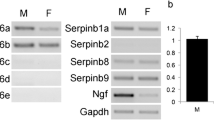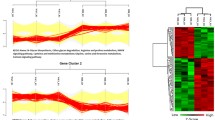Abstract
Acute metabolic acidosis and alkalosis cause a series of homeostatic adaptive responses in the kidney and other epithelia. We hypothesized that acid/base disturbances might affect the expression of Na+/H+ exchanger (NHE) isoforms in salivary glands and determined the expression and cellular distribution of NHE3 and NHE4 in rat submandibular glands of controls and after imposed acute or chronic metabolic acidosis or alkalosis in vivo. Reverse transcription/polymerase chain reaction, in situ hybridization, and immunohistochemistry were applied by using specific primers, antisense probes, and antibodies, respectively. The results showed NHE3 and NHE4 transcript expression and protein abundance in rat submandibular gland. NHE3 was apically localized in duct cells, whereas NHE4 was found basolaterally distributed in acinar and duct cells. Acute acidosis and alkalosis and chronic acidosis had no effect on NHE3 and NHE4 expression and localization. In contrast, chronic metabolic alkalosis significantly decreased the number of apically stained NHE3 duct cells but had no effect on NHE3 mRNA expression. The results demonstrate, for the first time, the presence of NHE4 protein in salivary glands. The data also indicate the distinct regulation and adaptive changes of different isoforms of the same transporter in rat submandibular gland as a response to acid/base disturbances.






Similar content being viewed by others
References
Alpern RJ, Cogan MG, Rector FCJ (1983) Effects of extracellular fluid volume and plasma bicarbonate concentration on proximal acidification in the rat. J Clin Invest 71:736–746
Ambühl PM, Amemiya M, Danczkay M, Lötscher M, Kaissling B, Moe OW, Preisig PA, Alpern RJ (1996) Chronic metabolic acidosis increases NHE3 protein abundance in rat kidney. Am J Physiol Renal Physiol 271:F917–F925
Anderie I, Blum R, Haase W, Grinstein S, Thévenod F (1998) Expression of NHE1 and NHE4 in rat pancreatic zymogen granule membranes. Biochem Biophys Res Commun 246:330–336
Bachmann O, Sonnentag T, Siegel W-K, Lambrecht G, Weichert A, Gregor M, Seidler U (1998) Different acid secretagogues activate different Na+/H+ exchanger isoforms in rabbit parietal cells. Am J Physiol Gastrointest Liver Physiol 275:G1085–G1093
Biemesderfer D, Rutherford PA, Nagy T, Pizzonia JH, Abu-Alfa AK, Aronson PS (1997) Monoclonal antibodies for high-resolution localization of NHE3 in adult and neonatal rat kidney. Am J Physiol Renal Physiol 273:F289–F299
Bookstein C, Musch MW, DePaoli A, Xie Z, Villeral M, Rao MC, Chang EB (1994) A unique sodium/hydrogen exchange isoform (NHE-4) of the inner medulla of the rat kidney is induced by hyperosmolarity. J Biol Chem 269:29704–29709
Bradford MM (1976) A rapid and sensitive method for the quantitation of microgram quantities of protein utilizing the principle of protein-dye binding. Anal Biochem 72:248–254
Chambrey R, St John PL, Eladari D, Quentin F, Warnock DG, Abrahamson DR, Podevin RA, Paillard M (2001) Localization and functional characterization of Na+/H+ exchanger isoform NHE4 in rat thick ascending limbs. Am J Physiol Renal Physiol 281:F707–F717
Eladari D, Leviel F, Pezy F, Paillard M, Chambrey R (2002) Rat proximal NHE3 adapts to chronic acid-base disorders but not to chronic changes in dietary NaCl intake. Am J Physiol Renal Physiol 282:F835–F843
Lee MG, Schultheis PJ, Yan Ming, Shull GE, Bookstein C, Chang E, Tse M, Donowitz M, Park K, Muallem S (1998) Membrane-limited expression of Na+-H+ exchanger isoforms by P2 receptors in the rat submandibular gland duct. J Physiol (Lond) 513:341–357
Lucioni A, Womack C, Musch MW, Rocha FL, Bookstein C, Chang EB (2002) Metabolic acidosis in rats increases intestinal NHE2 and NHE3 expression and function. Am J Physiol Gastrointest Liver Physiol 283:G51–G56
Luo X, Choi JY, Ko SBH, Pushkin A, Kurtz I, Ahn W, Lee MG, Muallem S (2001) HCO3 − salvage mechanisms in the submandibular gland acinar and duct cells. J Biol Chem 13:9808–9816
McLean IW, Nakane PF (1974) Periodate-lysine paraformaldehyde fixative: a new fixative for immunoelectron microscopy. J Histochem Cytochem 22:1077–1083
Orlowski J, Grinstein S (2004) Diversity of the mammalian sodium/proton exchanger SLC9 gene family. Pflügers Arch-Eur J Physiol 447:549–565
Orlowski J, Kandasamy RA, Shull GE (1992) Molecular cloning and putative members of the Na+/H+ exchange gene family. J Biol Chem 267:9331–9339
Park K, Olschowska JA, Richardson LA, Bookstein C, Chang EB, Melvin JE (1999) Expression of multiple Na+/H+ exchanger isoforms in rat parotid acinar and ductal cells. Am J Physiol Gastrointest Liver Physiol 39:G470–G478
Park K, Evans RL, Watson GE, Nehrke K, Richardson L, Bell SM, Schultheis PJ, Hand A, Shull GE, Melvin JE (2001) Defective fluid secretion and NaCl absorption in the parotid glands of Na+/H+ exchanger-deficient mice. J Biol Chem 276:27042–27050
Pizzonia JH, Biemesderfer D, Abu-Alfa AK, Wu M-S, Exner M, Isenring P, Igarashi P, Aronson PS (1998) Immunochemical characterization of Na+/H+ exchanger isoform NHE4. Am J Physiol Renal Physiol 275:F510–F517
Rickmann M, Wolff JR (1995) S100 protein expression in subpopulations of neurons of rat brain. Neuroscience 67:977–991
Robertson MA, Woodside M, Foskett JK, Orlowski J, Grinstein S (1997) Muscarinic agonists induce phosphorylation-independent activation of the NHE1-isoform of the Na+/H+ antiporter in salivary acinar cells. J Biol Chem 272:287–294
Roussa E (2001) H+ and HCO3 − transporters in human salivary glands. An immunohistochemical study. Histochem J 33:337–344
Roussa E, Thévenod F (1998) Distribution of V-ATPase in rat salivary glands. Eur J Morphol 36 (Suppl):147–152
Roussa E, Thévenod F, Sabolic I, Herak-Kramberger CM, Nastainczyk W, Bock R, Schulz I (1998) Immunolocalization of vacuolar type H+-ATPase in rat submandibular gland and adaptive changes induced by acid-base disturbances. J Histochem Cytochem 46:91–100
Roussa E, Romero MF, Schmitt BM, Boron WF, Alper SL, Thévenod F (1999) Immunolocalization of anion exchanger AE2 and Na+-HCO3 − cotransporter in rat parotid and submandibular glands. Am J Physiol Gastrointest Liver Physiol 40:G1288–G1296
Roussa E, Alper SL, Thévenod F (2001) Immunolocalization of anion exchanger AE2, Na+/H+ exchangers NHE1 and NHE4, and vacuolar type H+-ATPase in rat pancreas. J Histochem Cytochem 49:463–474
Sabolic I, Brown D, Gluck SL, Alper SL (1997) Regulation of AE1 anion exchanger and H+-ATPase in rat cortex by acute metabolic acidosis and alkalosis. Kidney Int 51:125–137
Thévenod F, Schulz I (1988) H+-dependent calcium uptake into an IP3-sensitive calcium pool from rat parotid gland. Am J Physiol Gastrointest Liver Physiol 255:G429–G440
Thévenod F, Anderie I, and Schulz I (1994) Monoclonal antibodies against MDR1 P-glycoprotein inhibit chloride conductance and label a 65-kDa protein in pancreatic zymogen granule membranes. J Biol Chem 269:24410–24417
Wright PA, Knepper MA (1990) Glutamate dehydrogenase activities in microdissected rat nephron segments: effects of acid-base loading. Am J Physiol Renal Physiol 259:F53–F59
Wu M-S, Biemesderfer D, Giebisch G, Aronson PS (1996) Role of NHE3 in mediating renal brush border Na+/H+ exchange. Adaptation to metabolic acidosis. J Biol Chem 271:32749–32752
Acknowledgements
The authors thank Dr. P. S. Aronson (Section of Nephrology, Department of Internal Medicine, Yale University School of Medicine, New Haven, Conn.) and Dr. S. Grinstein (Division of Cell Biology, Hospital for Sick Children, Toronto, Canada) for providing the anti-NHE4 antibodies, and Karen Fricke for excellent technical assistance.
Author information
Authors and Affiliations
Corresponding author
Additional information
This study was supported by a grant from the Deutsche Forschungsgemeinschaft (RO24495/1–1).
Rights and permissions
About this article
Cite this article
Oehlke, O., Sprysch, P., Rickmann, M. et al. Na+/H+ exchanger isoforms are differentially regulated in rat submandibular gland during acid/base disturbances in vivo. Cell Tissue Res 323, 253–262 (2006). https://doi.org/10.1007/s00441-005-0055-6
Received:
Accepted:
Published:
Issue Date:
DOI: https://doi.org/10.1007/s00441-005-0055-6




